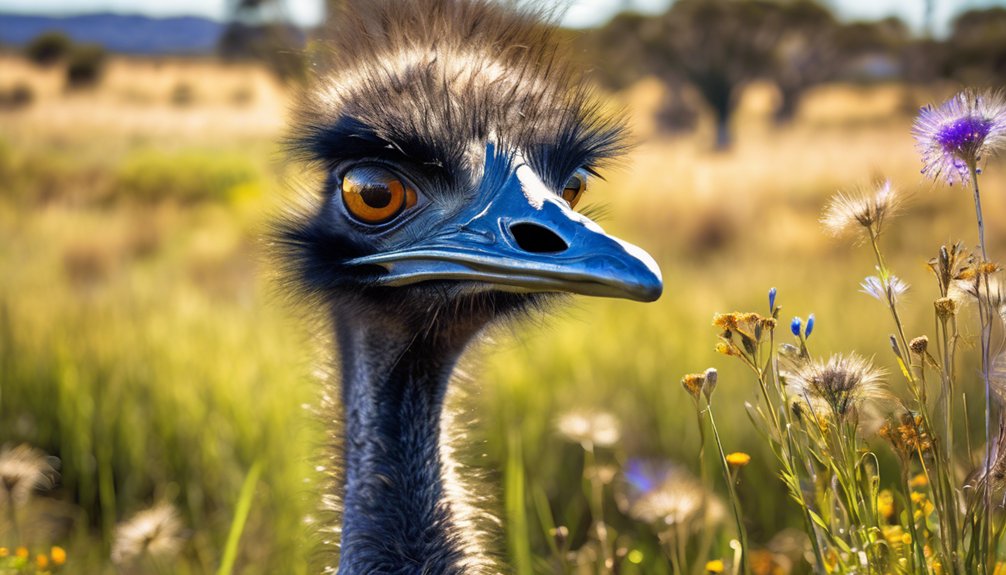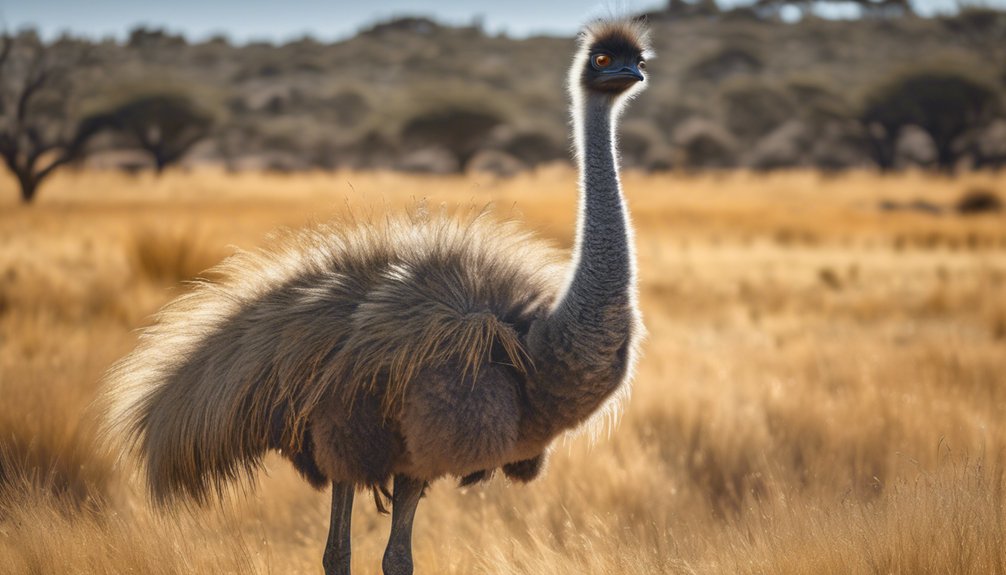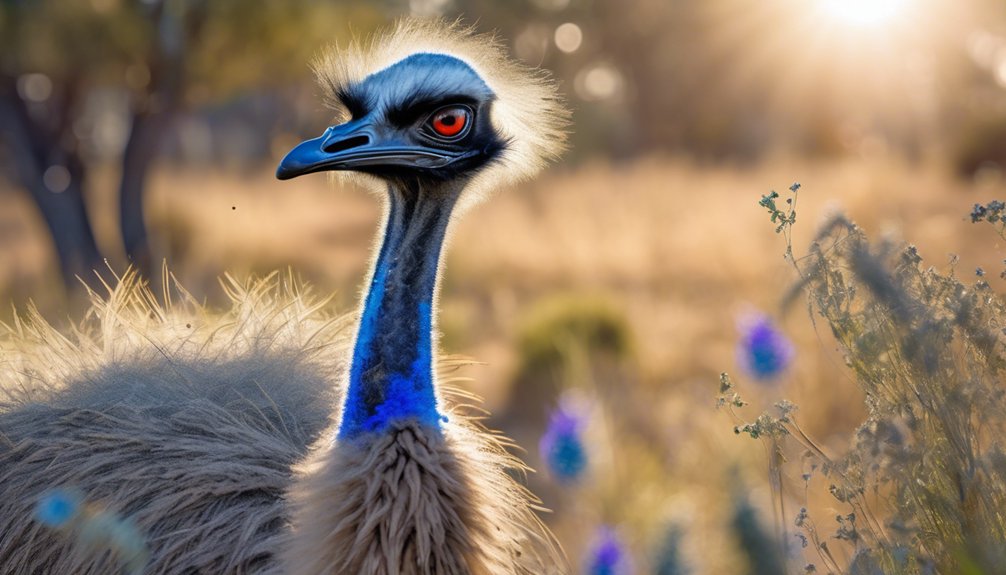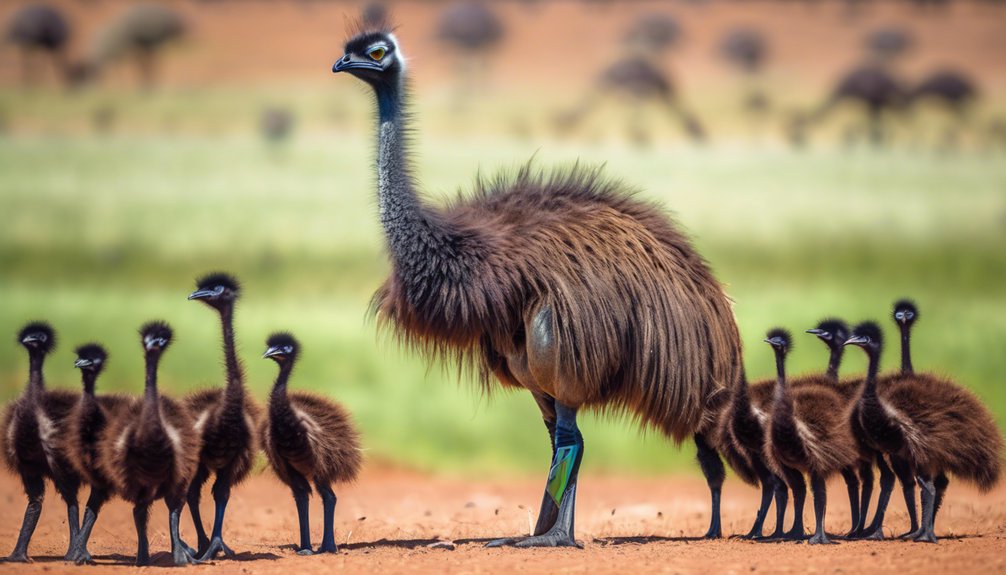
It's interesting how many people might not realize that emus, Australia's iconic flightless birds, play a significant role in their ecosystem. Standing up to 6 feet tall and weighing around 120 pounds, these birds are more than just a curious sight. Their unique adaptations and social behaviors offer insights into survival strategies in diverse habitats. As we explore their physical traits and ecological significance, you'll discover aspects of emus that might surprise you.
Key Takeaways
- Emus are the second-largest living birds, standing 5 to 6 feet tall and weighing up to 120 pounds.
- They thrive in diverse Australian habitats, including grasslands, woodlands, and scrublands.
- Their diet consists of grasses, seeds, fruits, and insects, foraging primarily in the early morning or late afternoon.
- Emus engage in elaborate mating rituals, with females laying 5 to 15 large, dark green eggs for males to incubate.
- Socially, emus form small groups with flexible hierarchies, communicating through vocalizations and body language.
Physical Characteristics of Emus

When you observe an emu, you'll notice its distinct physical traits that set it apart from other birds. One of the most striking features is its unique feather structure; rather than the typical smooth feathers, emu feathers are more hair-like, contributing to their insulation and adaptability.
This distinctive texture also gives the emu a rugged appearance, enhancing its charm. In terms of body size, emus are the second-largest living birds, averaging around 5 to 6 feet tall, with a robust build that can weigh up to 120 pounds.
Their long legs, designed for running, and large feet help them navigate the diverse Australian terrain efficiently. These attributes not only define the emu's appearance but also its survival strategies.
Habitat and Distribution
Emus thrive in a variety of habitats across Australia, showcasing their adaptability to different environments. These flightless birds exhibit unique habitat preferences, typically favoring open grasslands, woodlands, and scrublands. Their geographic range extends from the northern tropics to the southern temperate regions, allowing them to inhabit diverse ecosystems.
| Habitat Type | Characteristics | Geographic Range |
|---|---|---|
| Grasslands | Open, grassy areas with few trees | Throughout Eastern Australia |
| Woodlands | Areas with scattered trees | Central to Southern Australia |
| Scrublands | Dense shrubs and low vegetation | Western Australia |
| Coastal Regions | Near sandy beaches and dunes | Coastal areas in the East |
Understanding these habitat preferences helps you appreciate how emus thrive in varying conditions, displaying remarkable resilience and adaptability.
Diet and Feeding Habits

A diverse diet fuels the emu's robust physiology and adaptability.
These remarkable birds employ various foraging techniques to seek out nourishment across their habitats. You'll find them rummaging through grasses, seeds, fruits, and even insects, showcasing their dietary preferences that reflect their opportunistic nature.
Emus are known to consume up to 3 kilograms of food daily, depending on availability. They often graze in the early morning or late afternoon, maximizing their foraging efficiency.
Their keen eyesight helps them locate food from afar, while their strong legs allow for swift movement between feeding grounds.
This adaptability not only sustains their energy needs but also enables them to thrive in shifting environments, ensuring their survival in the wild.
Breeding and Reproduction
With a solid understanding of their diet, it's important to explore how emus reproduce and raise their young.
Emus engage in elaborate mating rituals, which often include intricate displays of vocalizations and physical movements to attract a partner.
Once a pair forms, the female lays between 5 to 15 large, dark green eggs, typically in a shallow nest on the ground.
After laying, the male takes on the responsibility of egg incubation, which lasts about 50 to 56 days. During this period, he remains dedicated, rarely leaving the nest.
This commitment not only ensures the eggs' warmth but also protects them from predators.
Once hatched, the chicks are precocial, quickly learning to forage and adapt to their environment.
Social Structure and Behavior

Understanding the social structure and behavior of emus reveals much about their interactions and group dynamics. These fascinating birds exhibit a flexible social hierarchy, often influenced by age and size.
When you observe them, you'll notice:
- Emus often form small groups, fostering strong bonds.
- Hierarchical interactions can change based on environmental factors.
- They communicate through various vocalizations and body language.
Within their groups, emus display intriguing behaviors such as cooperative foraging and mutual grooming, which strengthen social ties.
Their social dynamics are essential for survival, as they navigate challenges together. By appreciating these aspects, you'll gain a deeper understanding of how emus thrive in the wild, balancing individual needs with the benefits of group living.
Adaptations to Environment
Emus exhibit remarkable adaptations that enable them to thrive in diverse Australian environments, particularly in arid and semi-arid regions.
Their ability to regulate body temperature is crucial for survival in extreme heat. You'll notice that emus can tolerate high temperatures during the day while seeking shade during the hottest hours, effectively managing their internal heat.
Additionally, their plumage plays a vital role in their camouflage techniques, blending seamlessly with the dry, earthy tones of their habitat. This natural disguise helps them avoid predators, enhancing their chances of survival.
Emus in Indigenous Culture

The emu holds significant cultural importance among Indigenous Australian communities, symbolizing both sustenance and spirituality. This majestic bird appears in numerous Dreamtime stories, connecting the people to their ancestral heritage.
Its cultural significance can be observed through:
- Traditional hunting practices
- Use in ceremonies and rituals
- Representation in art and storytelling
Emus provide a vital food source, showcasing the deep relationship between the land and its people.
In Indigenous narratives, these birds often embody wisdom and resilience, imparting lessons about survival and harmony with nature.
You'll find that the emu not only sustains life but also enriches cultural identity, reminding communities of their connection to the earth and the stories that shape their existence.
Conservation Status and Threats
Cultural ties to emus highlight the need to address their conservation status, as these birds face increasing threats in their natural habitats.
Habitat destruction—primarily due to agricultural expansion and urban development—poses a significant risk to emu populations. As you delve into their plight, you'll discover that conservation efforts are underway, but they require your support.
Organizations are working diligently to restore habitats and protect nesting sites, yet challenges persist. Invasive species also threaten their survival, competing for resources and altering ecosystems.
Fun Facts About Emus

While you may know emus as flightless birds native to Australia, their fascinating characteristics extend far beyond their inability to fly.
Here are some intriguing aspects of emu communication and behavior:
- Emus use a variety of vocalizations for communication, including booming calls that can carry for miles.
- These birds are highly social, often forming groups that help them navigate and forage for food together.
- Emus display complex behaviors, such as a unique courtship dance that showcases their physical agility.
Their social structures and vocal communication reveal a depth of interaction that's rarely explored.
Understanding emu behavior not only highlights their adaptability but also enriches our appreciation for these remarkable creatures.
Emus truly are more than meets the eye!
Frequently Asked Questions
How Fast Can Emus Run Compared to Other Birds?
When you explore emu speed comparison, you'll find these flightless birds can sprint up to 30 miles per hour. Their adaptations for running, like strong legs and a streamlined body, enhance their impressive agility in the wild.
Do Emus Have Any Natural Predators in the Wild?
In the wild, emus face natural predators like dingoes and wedge-tailed eagles. Their defense mechanisms include speed and agility, allowing them to escape threats, highlighting their remarkable adaptation to survive in their environment.
How Long Can Emus Live in Captivity?
You might be surprised to learn that in captivity, emus can live up to 20 years. With proper emergency care and understanding their breeding habits, you can ensure their longevity and well-being. It's a fascinating journey!
Can Emus Swim, and if So, How Well?
Yes, emus can swim surprisingly well. Their strong legs and buoyant bodies enable effective emu swimming, showcasing their unique emu abilities. They often navigate water effortlessly, demonstrating adaptability beyond their renowned flightless nature.
Are There Any Unique Sounds That Emus Make?
When you listen closely, emus express their world through vocal communication. Their sound variations symbolize emotions, from deep booming calls to softer clucks, revealing a complex language that reflects their social interactions and environmental awareness.
Conclusion
In conclusion, emus are not just symbols of Australia's unique wildlife; they embody resilience and adaptability in the face of change. From their towering stature to their intricate social bonds, these flightless birds navigate their environment with remarkable finesse. As you explore the depths of their behavior and habitat, remember that preserving their existence is vital, like safeguarding a piece of Australia's natural tapestry. Emus remind us of the delicate balance between nature and survival, urging us to act.




